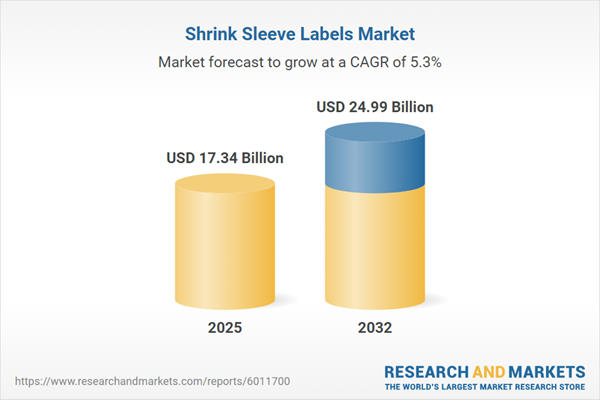Speak directly to the analyst to clarify any post sales queries you may have.
Senior decision-makers focused on packaging innovation, compliance, and sustainability are increasingly turning to the global shrink sleeve labels market for solutions that align with current standards and future-proof their operations. This dynamic market helps businesses respond to changing regulatory and consumer demands, enabling operational agility and strong brand presence.
Shrink Sleeve Labels Market Snapshot
The shrink sleeve labels market continues its resilient upward trajectory as organizations across various industries seek to differentiate products in highly competitive retail environments. Expansion in print technologies is a key catalyst, enabling more sophisticated label designs that enhance shelf appeal and brand recognition. At the same time, a heightened focus on sustainability drives innovation and responsible material sourcing. Changes in material standards and new compliance expectations are affecting both production methodologies and market strategies, prompting organizations to prioritize flexibility in packaging, regulatory alignment, and operational efficiency.
Scope & Segmentation: Shrink Sleeve Labels Market
Comprehensive segmentation supports executive decision-makers in optimizing investments and mitigating compliance risk. By examining key market divisions, business leaders are equipped to make precise choices that support both strategic goals and technical execution across international markets.
- Applications: Utilized across food, beverage, household chemical, personal care, and pharmaceutical markets, each application brings unique safety, branding, and compliance requirements tied to sector-specific priorities.
- Material Types: Solutions include oriented polystyrene, polyethylene terephthalate, polylactic acid, polyolefin, and polyvinyl chloride, with a focus on durability, compliance, and support for sustainability programs.
- Container Types: Used with bottles, jars, cans, tubes, and pouches, helping brands enhance visual impact and product differentiation within diverse retail categories.
- Printing Technologies: Processes such as digital, flexographic, rotogravure, and screen printing enable versatile label production to satisfy region-specific compliance and accelerate time-to-market for new launches.
- Regional Coverage: Strategies are influenced by regulatory and design trends in the Americas, Europe, Asia-Pacific, and Middle East & Africa, with each region exhibiting distinct preferences that impact packaging format and compliance approaches.
- Profiled Companies: Leading industry participants like CCL Industries Inc., Avery Dennison Corporation, Berry Global Group, Inc., Huhtamaki Oyj, and Fuji Seal International, Inc. demonstrate robust adaptation and innovation within a shifting market landscape.
Leveraging these segmentation criteria enables tailored product innovation and a disciplined approach to evolving regulatory and sustainability imperatives.
Shrink Sleeve Labels Market: Key Takeaways for Decision-Makers
- Modern print and automation systems enhance the ability to quickly respond to new regulations and more stringent sustainability standards.
- Selecting recyclable and renewable shrink sleeve materials supports organizations in meeting environmental responsibility targets and cultivating stronger consumer trust.
- E-commerce and direct-to-consumer growth is raising demand for packaging that delivers both product protection and engaging brand interaction.
- Differences in regional supply chain strategies influence market diversity, with established markets prioritizing compliance and traceability, while emerging regions look for scalable, adaptive solutions.
- Data-driven operational processes and automation contribute to higher quality, cost optimization, and the capacity to adapt as sector requirements develop.
Tariff Impact and Market Adjustments
Targeted tariffs on raw materials and equipment in key regions are prompting manufacturers to adapt procurement strategies. Many are adopting localized or near-shoring production models to reduce logistics volatility and secure stable supply chains, maintaining reliability even amid economic shifts.
Methodology & Data Sources
This analysis incorporates interviews with packaging engineers, procurement specialists, and sustainability executives. Data is verified using technical documentation and regular trend monitoring, resulting in practical guidance for decision-makers in the shrink sleeve labels market.
Why This Report Matters
- Enables leaders to segment packaging initiatives and respond confidently to changing regulatory environments.
- Provides up-to-date intelligence on material advances, printing applications, and evolving technology, supporting effective allocation of resources.
- Equips organizations for proactive risk and supply chain management to maintain competitive positioning as legislative and market conditions evolve.
Conclusion
Leaders gain clear direction in shaping innovative and compliant shrink sleeve label strategies. Ongoing advances in material and process adaptation will position organizations to address emerging demands and secure operational readiness.
Additional Product Information:
- Purchase of this report includes 1 year online access with quarterly updates.
- This report can be updated on request. Please contact our Customer Experience team using the Ask a Question widget on our website.
Table of Contents
3. Executive Summary
4. Market Overview
7. Cumulative Impact of Artificial Intelligence 2025
List of Figures
Companies Mentioned
The companies profiled in this Shrink Sleeve Labels market report include:- CCL Industries Inc.
- Avery Dennison Corporation
- Constantia Flexibles Group GmbH
- Multi-Color Corporation
- WS Packaging Group, LLC
- UPM-Kymmene Corporation
- Berry Global Group, Inc.
- Fuji Seal International, Inc.
- Huhtamaki Oyj
- LINTEC Corporation
Table Information
| Report Attribute | Details |
|---|---|
| No. of Pages | 184 |
| Published | November 2025 |
| Forecast Period | 2025 - 2032 |
| Estimated Market Value ( USD | $ 17.34 Billion |
| Forecasted Market Value ( USD | $ 24.99 Billion |
| Compound Annual Growth Rate | 5.3% |
| Regions Covered | Global |
| No. of Companies Mentioned | 11 |









